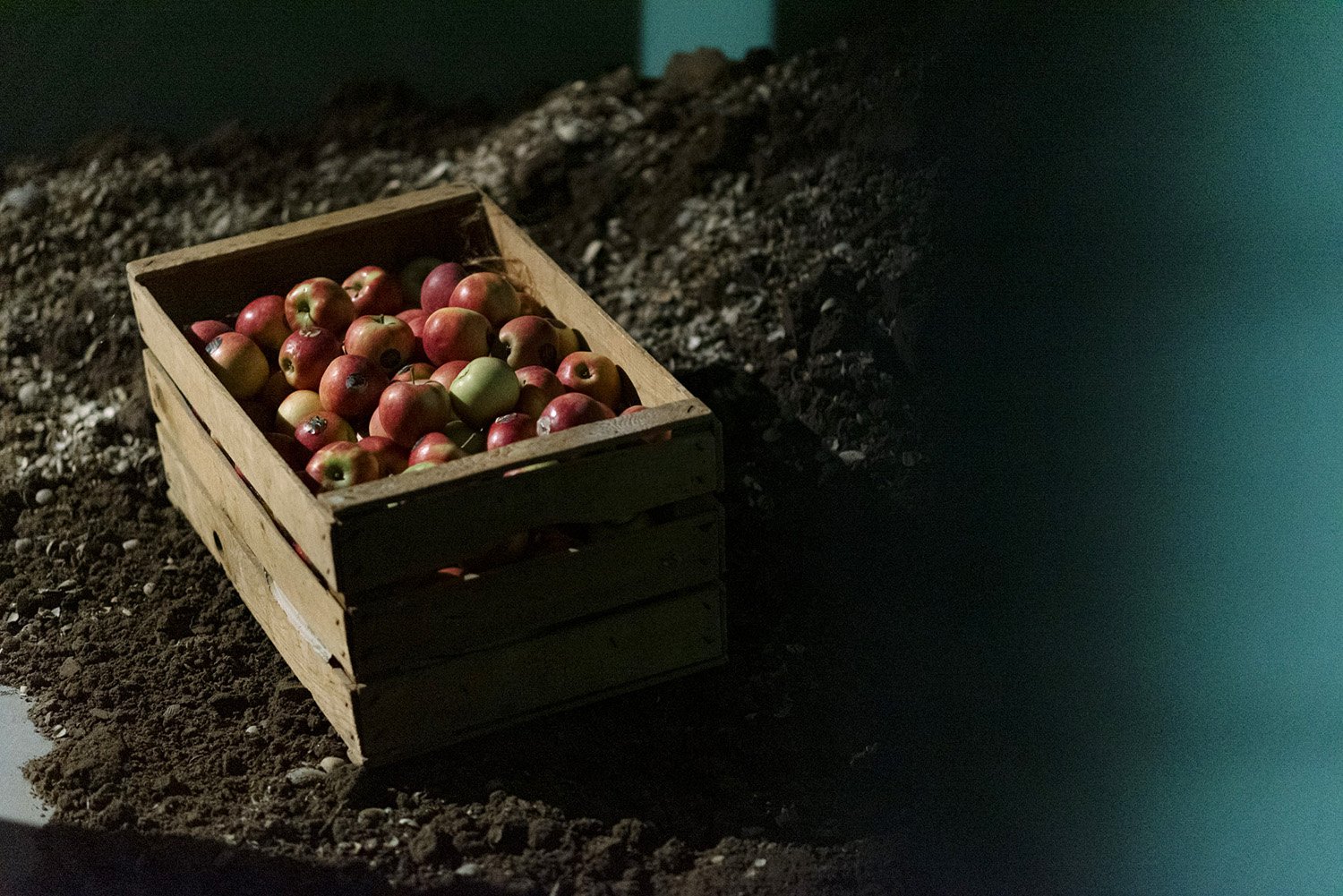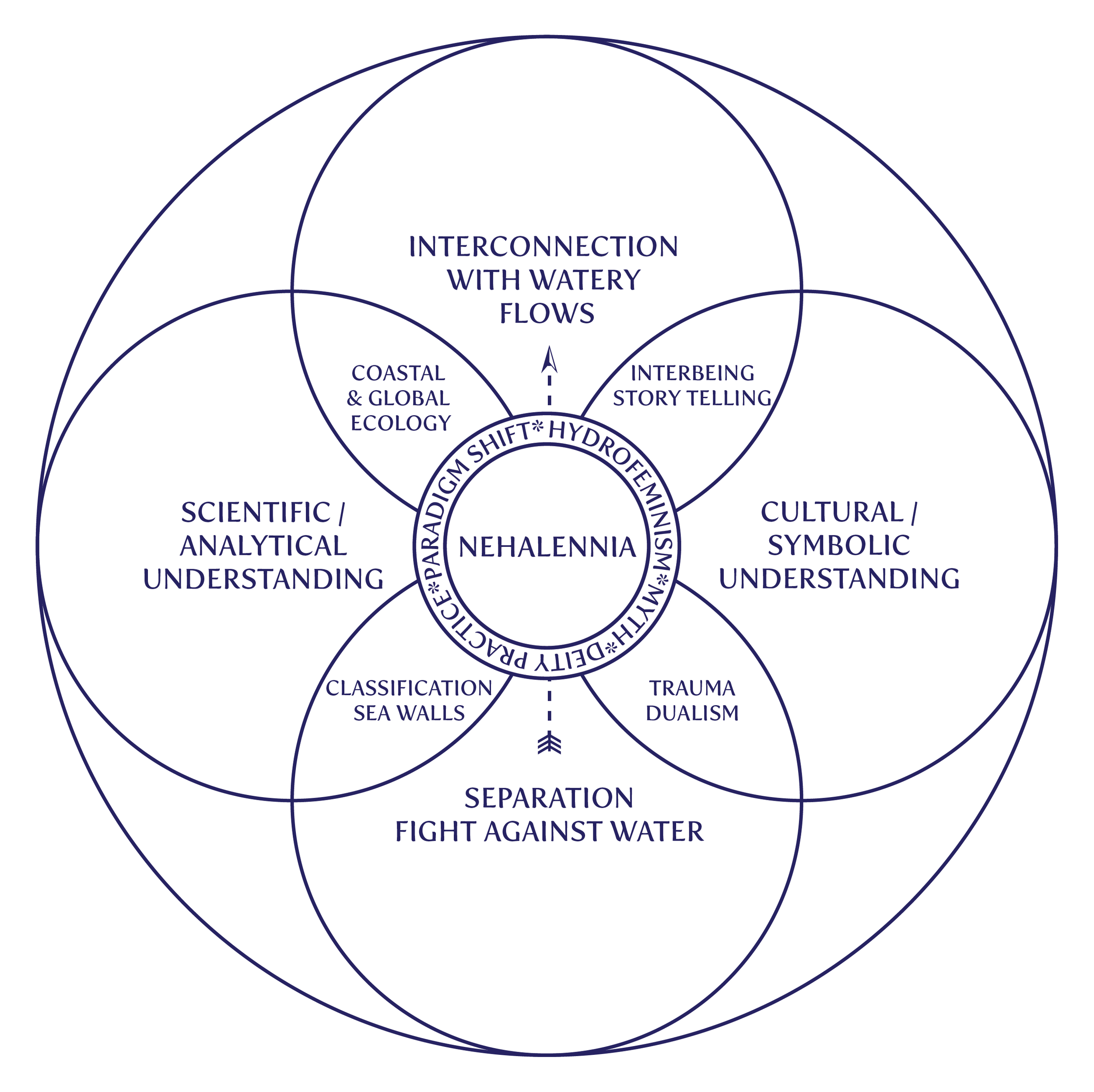MUD & FLOOD
THE RETURN OF NEHALENNIA













A contemporary temple to a long-forgotten goddess of the Zeeland sea, where she emerges as a 21st-century hydrofeminist created by an image-generating AI. In chorus with scientists from the Royal Netherlands Institute for Sea Research (NIOZ), she teaches us that the border between land and water should be a soft border, not a hard border of basalt blocks and high dykes. As it is the mud and vegetation of coastal ecosystems that protect us from rising waters.
The story of Nehalennia, dating back to the 2nd century BC, can teach us to understand why transitional areas are important and give meaning to the ‘sacrifice’ of human spaces for non-human habitats. It recreates a living relationship with the sea that was once lost but is now returning based on scientific understanding. The resurrection of a pre-Roman goddess, together with scientist Marte Stoorvogel of NIOZ, is an attempt to create a story that is rich and local and at the same time part of a global discourse in which the climate emergency forces us to re-evaluate our entire relationship to nonhuman beings and forces.
INSTALLATION
The story of Nehalennia is told through talking seashells, an AI-generated triptych and interactive elements.
The installation was inspired by rites of passage, ceremonies that guide participants through significant transitions in life. The project invites visitors to enact such a ritual in times when a paradigm shift is taking place in coastal protection practices. Rites of passage are oftentimes structured in 3 parts, which are also present (and can be interacted with) in our installation:
SEA (separation) - Offer Your Hair to Dancing Seaweed
MUD (transformation) - Drink the Mud from the Altar
LAND (integration) - Take an Apple with a Message
CONTEXT
The Netherlands is a river delta, with a large part of the country below sea level. For centuries, land has been reclaimed from the sea by the construction of dikes, levees and pumps–engaged in a constant fight against the forces of nature. There is an old saying: "God created the world, but the Dutch created the Netherlands". These lowlands are in crisis, as rising sea levels due to the climate emergency push hard barriers to their limits, risking disastrous floods. A paradigm shift is happening, where scientists and engineers are trying to find ways of building with nature instead of against it. We now realize that the ecosystems that used to exist in these areas, the mud flats and salt marshes that were historically considered ‘evil places’, play a key role in mitigating floods and storm damage. They absorb the force of waves, prevent erosion and dynamically adapt to sea level changes. Furthermore, they are one of the most biodiverse places in the Netherlands.
Conventional coastal engineering and Ecosystem-based coastal defence
This realisation is controversial because it means we have to give up some agency and control (actual or imagined) over the natural forces of water. In some places, dykes will have to be opened and some of the reclaimed land returned to the sea. People will have to move, mosquitoes and smells might return, and we have to accept some risk as we renegotiate a cohabitation with natural processes.
Water flows through bodies, species and materialities, connecting them for better or worse. Today, planetary thinking is feminist thinking.
- Elena Lundquist Ortiz
We see this as an opportunity for a turn to a hydrofeminist relationship to the water, the deltas, the mud, the marshes. A shift in which humans are no longer fighting heroic battles against danger and evil, but feel dependent on the nonhuman beings with whom they share ecological habitats, interconnected through the waters.
However, this realisation changes not only our actions but our whole way of thinking and how we understand the world. A transformation that takes place not only on a technological and scientific level but also on a philosophical and mythological one. To underline this, we attempt to revive the ancient myth of the goddess ~Nehalennia~, and create a new cosmogonic narrative based on the current scientific understanding of the mud and the flood.
How can mythology help us cope with the sacrifice of control over flood-scapes?
Nehalennia is a goddess of unclear origin, perhaps Germanic or Celtic. She is depicted upon numerous altars discovered around Zeeland, dating back at least to the 2nd century BC. Her name might mean "she who is at the sea".
In 1970, a fisherman near Colijnsplaat found sculptures of the goddess in his nets, leading to the discovery of a submerged pre-roman temple with numerous altars. She might have been a deity of seafare, possibly horticulture and fertility, sometimes described as the mother goddess, a symbol of death, rebirth and protection.
Because her symbolism is mostly forgotten, we revive this mythological goddess and re-imagine her as a hydrofeminist deity of the water of the marshlands. Not a representation of evil, but one of rebirth, of recognizing cycles, impermanence, and interdependence.
A severe storm on 5 January 1647 brought to the surface dozens of stone monuments, dedicated to the goddess Nehalennia, on the beach of the town of Domburg. Over three centuries later, the goddess surfaced again. On 14 April 1970, the fisherman Kees Bout discovered four large pieces of stone in his nets while fishing in the Oosterschelde, near Colijnsplaat, leading to the discovery of the remains of a submerged temple built for Nehalennia.
can we consciously evoke Nehalennia to transform our relationship with the sea?
Nehalennia and the hydrofeminist relation-shift
Mythology is world-making – stories make worlds, and worlds make stories. Numerous creation myths around the world speak of the origin of life coming out of mud and clay–the formation of the world. Likewise, there are numerous depictions of a great flood sent by deities that destroy civilization–the destruction of the world.
These prophetic mythologies have been replaced by scientific predictions. We hear scientific advice on the importance of mudflats for the survival of life, and predictions of rising sea levels and increased flood risks threatening our societies. The scientists of NIOZ are experts on the mud and the flood and were thus perfect partners to create a new functional mythology of mudflats and sea level rise.
Saltmarsh dynamics
The revival of Nehalennia is not a return to superstition or irrationality. Science and evidence should continue to form a solid basis for our understanding of the material world, especially when that view shifts, such as in this case our new understanding of coastal protection and restoration.
What we propose is a relation to the deity not as an externally existing omnipotent entity, but as an archetypal manifestation of mind, that we consciously evoke to transform our own way of thinking, and connect with a deeper level of existing - such as impermanence, inter-species entanglement, and interbeing.
Triptych made together with image generating AI DALL-E2. The Triptych (SEA-MUD-LAND) incorporates symbols from the ancient votive altars of Nehalennia and elements related to the work of NIOZ.
Credits
Science by Marte Stoorvogel (Dept. of Estuarine & Delta Systems at NIOZ)
Text & Voice by Céline Mathieu
Sound design by Birt Berglund
AI-generated triptych made with DALL-E2
Nehalennia votive altar lent by Zeeuws Museum
Opportunity & support by BAD award
Curation by Angelique Spaninks
Photos by Max Kneefel and Filips Staņislavskis











